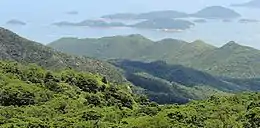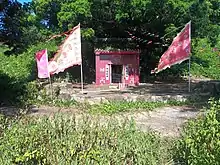索罟群島 | |
|---|---|
 View of the Soko Islands from Tian Tan Buddha. The hills in the foreground are part of Lantau Island. | |
| Geography | |
| Location | Southwest of Lantau Island |
| Coordinates | 22°10′26.0394″N 113°54′39.6″E / 22.173899833°N 113.911000°E |
| Archipelago | Soko Islands |
| Total islands | 11 |
| Major islands | Tai A Chau, Siu A Chau |
| Administration | |
| District | Islands District |
| Soko Islands | |||||||||||||
|---|---|---|---|---|---|---|---|---|---|---|---|---|---|
| Traditional Chinese | 索罟群島 | ||||||||||||
| Simplified Chinese | 索罟群岛 | ||||||||||||
| |||||||||||||
.jpg.webp)
The Soko Islands (Chinese: 索罟群島) are a group of islands in Hong Kong. The group consists of Tai A Chau, Siu A Chau and several smaller nearby islands, in the southwesternmost waters of the territory, to the southwest of Lantau Island.
An older name for this island group was "Sok Kwu Kwan To" (Fishing Net Islands).[1]
The islands are mainly composed of granite and a band of rhyodacite. Waters of the island group are brackish due to being in the Pearl River estuary.[2]
Islands
The islands of the group are:
- Cheung Muk Tau (樟木頭)
- Ko Pai (高排)
- Lung Shuen Pai (龍船排)
- Ma Chau (孖洲)
- Shek Chau (石洲)
- Siu A Chau (小鴉洲)
- Tai A Chau (大鴉洲)
- Tau Lo Chau (頭顱洲)
- Wan Hau Chau (灣口洲)
- Yuen Chau (圓洲)
- Yuen Kong Chau (圓崗洲)
History
Now uninhabited,[3] the islands formerly accommodated a refugee camp for Vietnamese boat people. Vietnamese detention centres were established in Hong Kong following waves of Vietnamese fleeing after the fall of Saigon in 1975. The Tai A Chau Detention Centre (IN59) was closed in September 1996.[2]
In 2016, CLP Power proposed the islands as site for a terminal to receive liquefied natural gas (LNG) for use in electricity generation. This proposal is opposed by local environmental groups because the surrounding waters are an important habitat for various marine species, particularly the rare Chinese white dolphin.[4][5]
In February 2020, OceansAsia reported finding 70 face masks washed up on one beach of the islands. The same beach was examined the following November, and OceansAsia volunteers reported collecting 54 more masks.[6][7][8]
Conservation
The soft shore beach of Siu A Chau can attract green turtles and the islands were proposed to be a protected marine park.[9]
The South Lantau Marine Park (南大嶼海岸公園) was designated as a marine park in June 2022. It encompasses the Soko Islands and an area between Siu A Chau and Tai A Chau. The stated aim of the marine park is to help conserve the Chinese white dolphins and finless Porpoises.[3]
Education
The Soko Islands are in Primary One Admission (POA) School Net 97. Within the school net are three aided schools (operated independently but funded with government money) on Cheung Chau; no government schools are in this net.[10]
References
- ↑ Strickland, John (1 June 2010). Southern District Officer Reports: Islands and Villages in Rural Hong Kong, 1910-60. Hong Kong University Press. p. 208. ISBN 978-988-8028-38-2.
- 1 2 Owen, Bernie; Shaw, Raynor (1 October 2007). Hong Kong Landscapes: Shaping the Barren Rock. Hong Kong University Press. p. 217. ISBN 978-962-209-847-3.
- 1 2 "South Lantau Marine Park". Agriculture, Fisheries and Conservation Department.
- ↑ "Hong Kong electric company plans floating LNG terminal near Soko Islands". South China Morning Post. 11 April 2016. Retrieved 12 June 2021.
- ↑ "'Clean up islands and waters before marine park designation'". South China Morning Post. 13 November 2017. Retrieved 12 June 2021.
- ↑ "'More masks than jellyfish': coronavirus waste ends up in ocean". the Guardian. 8 June 2020. Retrieved 12 June 2021.
- ↑ "More than 1.56 billion face masks could end up polluting oceans: report". CTVNews. 7 December 2020. Retrieved 12 June 2021.
- ↑ "Discarded coronavirus masks clutter Hong Kong's beaches, trails". Reuters. 12 March 2020. Retrieved 12 June 2021.
- ↑ Morton, Brian (1 January 2003). Perspectives on Marine Environmental Change in Hong Kong and Southern China, 1977-2001: Proceedings of an International Workshop Reunion Conference, Hong Kong, 21-26 October 2001. Hong Kong University Press. p. 811. ISBN 978-962-209-641-7.
- ↑ "POA School Net 97" (PDF). Education Bureau. Retrieved 12 September 2022.
External links
 Media related to Soko Islands at Wikimedia Commons
Media related to Soko Islands at Wikimedia Commons
